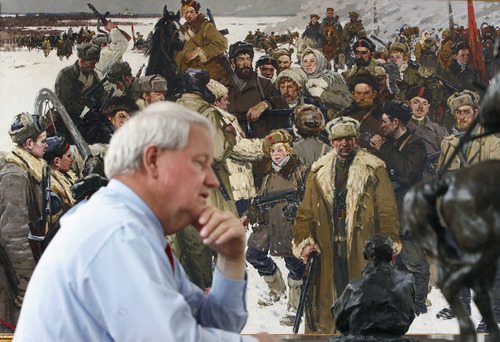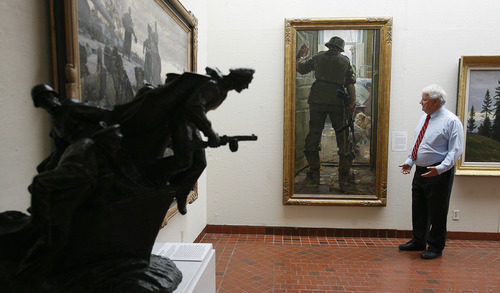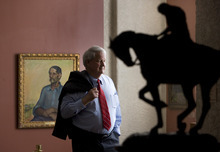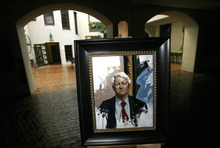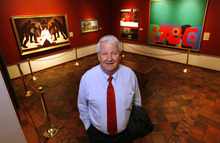This is an archived article that was published on sltrib.com in 2012, and information in the article may be outdated. It is provided only for personal research purposes and may not be reprinted.
Springville • Vern Swanson acknowledges that the painting "Home From the War," by the late Utah painter Verla Leone Birrell, isn't the greatest artwork ever created. But it still excites him.
The painting, hanging in the Springville Museum of Art, depicts a bustling train station as soldiers and sailors return home from World War II. In the jumble of shapes and colors, Swanson sees the immediacy of the situation.
"Only that painting has something to say about that moment," Swanson said, showing a reporter around the museum Monday.
Swanson, who is retiring this summer after 32 years as director of the respected museum in Utah's "Art City," believes "every painting has a story" — and has worked to make the Springville Museum of Art the place to tell them.
"He has more enthusiasm then the Energizer Bunny," says Swanson's friend, Jim Dabakis, an art dealer and Utah State Democratic Party chairman.
—
Recognizing a Fairbanks sculpture • Swanson was a freshman at Brigham Young University in 1964, beginning a "very unstellar career" as a running back for the Cougars football team, when he first visited the Springville Museum of Art.
He hitchhiked from Provo one day, after two-a-day football practice, and arrived just minutes after the place closed. "The lady [locking up] says, 'I have to leave, I have appointments,'" Swanson recalled. But the lady also saw the young man desperately needed a drink of water, so she let him in for a moment.
On the way out, Swanson pointed to a sculpture and said, "That's a Fairbanks buffalo!" Impressed that Swanson recognized the work of Provo-born sculptor Avard T. Fairbanks, she let him look around the whole museum. When he was finished, Swanson said, the lady "slapped me on my knee and said, 'One day, you should be curator of this gallery.'"
In 1980, while working on his doctorate degree at the University of London, Swanson learned from his wife, Judy, that the job was available. In the interim, Swanson had studied at BYU and the University of Utah, taught art and art history at Auburn University, and had worked at the National Gallery of Art. He said he wasn't sure he wanted the job then. "I was looking at something bigger," he said.
Swanson went to Madrid and asked a friend, the Utah fantasy painter James Christensen, whether he should apply for the Springville job or go back to work at Wasatch Bronzeworks while completing his doctorate. "Jim said to me, 'Do you want to work at an art museum or get bronze dust down your shorts?'" Swanson called Judy and told her to put in his application.
—
A fever for Soviet realist art • The Springville Museum of Art was founded in 1903, and is billed as the oldest in the Intermountain West. "It just reeked of culture," is what Swanson thought when he came to the museum for his job interview. "There are bigger museums, but not many more beautiful than this one."
It was also a museum casting about for a mission. The previous three directors, all short-timers, were all modernists. "I'm not a modernist, I'm a traditionalist," Swanson said proudly.
Because of that philosophy, those who know him find it odd that an exhibit now hanging in one gallery, taken from his and Judy's personal collection, has several modernist works, including that Birrell painting of returning war veterans.
In his tenure, Swanson has overseen the museum's expansion — and the creation of a gorgeous sculpture garden. He also helped the museum gain an international reputation for its collection of art from the old Soviet Union.
"If you had told me in the fall of 1989 that I'd become an expert on Soviet socialist realist art, I'd say, 'Do you have a fever?'" Swanson said.
It was on a trip to Moscow that Swanson met Dabakis, then a fledgling art dealer, and together they unearthed thousands of works depicting war, revolution, collective farms and daily life in the then-disintegrating Soviet Union.
"There was no such thing as Russian realism until Vern Swanson invented it," Dabakis said. "He really changed the world of art."
—
Becoming the museum's grandparent • It's an odd claim to fame for a Utah Mormon who, politically, "makes Glenn Beck look like a liberal," Dabakis said, but adding: "Vern lets no ideology stand between him and great art."
One reason Swanson brought the Russian art to Utah was to influence Utah artists.
"The [Soviet] art is here to kick Utah art in the pants, and it's done that," Swanson said. "I couldn't keep the Utah artists away. Artists would come and cry. They were overwhelmed by its power, strength — its beauty, really."
At 67, Swanson's enthusiasm remains strong, but his kidneys are weak — so his doctors advised him to retire.
Swanson will take the title of "director emeritus," remain on the board of trustees and consult when asked. "My goal is not to hover" over the new director, whose name has yet to be announced. "I'm ceasing to be the parent, but I'm becoming the grandparent," he said.
He also has more books to write, a trip to Israel planned and a mission for the LDS Church at the Missionary Training Center in Provo.
The Springville Museum of Art will continue to tell stories — and a few will be about him.
"In a hundred years," Dabakis said, "they're still going to be telling Vern Swanson stories."
Saying 'good-pie' to Vern Swanson
P The Springville Museum of Art will hold an open house in honor of Vern Swanson's retirement as museum director, a "good-pie" party with pies baked by friends and patrons.
Where • Springville Museum of Art, 126 E. 400 South, Springville
When • Wednesday from 6 p.m. to 8 p.m.
Admission • Free




